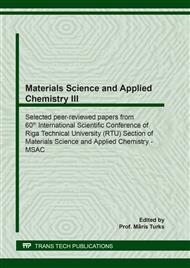[1]
United Nations/Framework Convention on Climate Change (2015) Adoption of the Paris Agreement, 21st Conference of the Parties, Paris: United Nations.
DOI: 10.29171/acku_pamphlet_k3585_5_a47_2018_n1288_english_title1
Google Scholar
[2]
L. Genovaite, B. Mindaugas, The European Union Possibilities to Achieve Targets of Europe 2020 and Paris Agreement Climate Policy, Ren.En. 106 (2017) 298-309.
DOI: 10.1016/j.renene.2017.01.036
Google Scholar
[3]
R.A. Betts, C.D. Jones, J.R. Knight, R.F. Keeling, J.J. Kennedy, El Nino and a Record CO2 Rise, Nat. Clim. Chang. 6 (9) (2016) 806-10.
DOI: 10.1038/nclimate3063
Google Scholar
[4]
E. Namsone, A. Korjakins, G. Sahmenko, M. Sinka, The Environmental Impacts of Foamed Concrete Production and Exploitation, Mat. Sc. And Eng. 251 (2017) 20-29.
DOI: 10.1088/1757-899x/251/1/012029
Google Scholar
[5]
E. Namsone, G. Sahmenko, E. Namsone, E. Namsone, A. Korjakins, Research on Properties of Composites Based on Magnesium Binders, Environment. Technology. Resources. Proceedings of the 12th International Scientific and Practical Conference. 1 (2019) 192-197.
DOI: 10.17770/etr2019vol1.4157
Google Scholar
[6]
C. De Wolf, F. Pomponi, A. Moncaster, A Measuring Embodied Carbon Dioxide Equivalent of Buildings, Energy Build. 140 (2017) 68-80.
DOI: 10.1016/j.enbuild.2017.01.075
Google Scholar
[7]
H.X. Li, L. Zhang, D. Mah, H. Yu, An Integrated Simulation and Optimization Approach for Reducing CO2 Emissions from On-Site Construction Process in Cold Regions, Energy Build. 133 (2017) 666-675.
DOI: 10.1016/j.enbuild.2016.12.030
Google Scholar
[8]
B. Lin, H. Liu, CO2 Mitigation Potential in China's Building Construction Industry: A Comparison of Energy Performance, Build. Environ. 94 (2015) 239-251.
DOI: 10.1016/j.buildenv.2015.08.013
Google Scholar
[9]
Information on https://www.rite.or.jp/system/en/latestanalysis/pdf/E-Comparison_Energy Intensity2010cement.pdf.
Google Scholar
[10]
J. Davidovits, Geopolymer Chemistry and Applications, Second ed., Saint-Quentin, (2008).
Google Scholar
[11]
V. Vaganov, A. Kireev, S. Avdeev, G. Sahmenko, M. Sinka, Prospects for Effective Use of Dolomite in Concrete Compositions, Cons. Sc. 19 (2016) 27-32.
DOI: 10.1515/cons-2016-0008
Google Scholar
[12]
U. Sharma, A. Khatri, A. Kanoungo, Use of Micro-Silica as Additive to Concrete-State of Art, Int. J. Civ. Eng. Res. 5 (2014) 9-12.
Google Scholar
[13]
Y.V. Ustinova, A.E. Nasonova, T.P. Nikiforova, V.V. Kozlov, Magnesium Binder with the Micro-Silica Additive, Proc. Moscow state Univ. Civ. Eng. 7 (2012) 147-151.
Google Scholar
[14]
H.A. Abdel-Gawwad, Kh.A. Khalil, Preparation and Characterization of One-Part Magnesium Oxychloride Cement, Constr Build Mater. 189 (2018) 745-750.
DOI: 10.1016/j.conbuildmat.2018.09.051
Google Scholar
[15]
M.A. Haque, B. Chen, Research Progresses on Magnesium Phosphate Cement: A Review, Constr Build Mater. 211 (2019) 885-898.
DOI: 10.1016/j.conbuildmat.2019.03.304
Google Scholar


